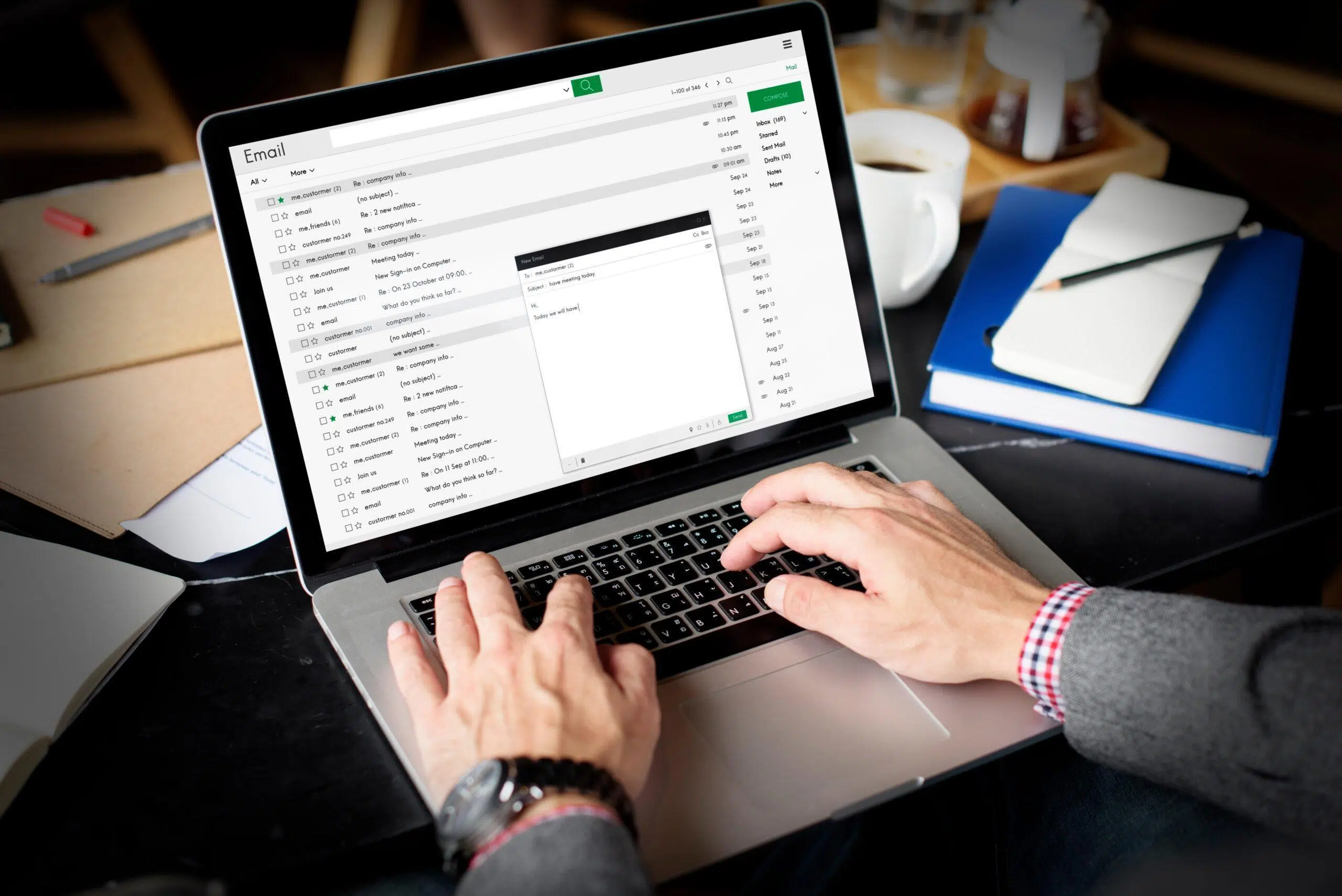Here’s everything about the proper etiquette for adding someone to an email thread:
Usually, the best way to add someone to an email thread is to include them on the CC line when you reply all to the existing thread.
You should also leave a short note explaining who you are adding to the conversation and why.
This will catch the new person up on the whole conversation and add them to the list.
So if you want to learn all about the right way to add someone to an email thread, then you’re in the right place.
Keep reading!
- CC, BCC, Reply All: Email Etiquette?
- Employers Reading Your Emails: After You Leave?
- Work Email to Personal Email: Okay to Send Email?
- OnlyFans Emails & Notifications: How To Stop?
- Purge Items When Switching Folders: Meaning?
- No Confirmation Email: What to Do?
- Deleting Emails: Frees Up Phone Space?
- One Asks For Email on Craigslist: Why?

What Are the Different Ways to Add Someone to an Email Thread? (5 Ways)

Before we can get into etiquette, it’s going to help a lot to discuss the mechanics of email conversations and the different ways you can actually go about adding someone to a thread.
It turns out that there is more than one way to do this.
I’m going to explain the easiest options, and by understanding the differences in how they work, you’ll be able to suss out a lot of etiquette on your own.
Not to worry, I’ll explain the etiquette in detail a little later.
#1 To

You can use the To line to add someone to an email chain.
You’ve probably used this line plenty of times, but I’m going to explain the technical bits of how it works to avoid any confusion.
When you put an email address in this line, then whatever you include in the email will be sent to the recipient on this line.
You can include multiple people on this line, and they all receive the exact same email.
On top of that, everyone who receives the email can see every email address that was included in this line.
To add someone to an email chain using the To line, you simply address an email to everyone and copy the new email into this line too.
That will include them on the list, and any future communication that uses this list will include the newcomer.
#2 CC

You can also use the CC line.
CC actually stands for “carbon copy,” and it’s a specialized tool that makes it easy to include someone in an email without putting them on the To line.
Why would that matter?
From a technical standpoint, it doesn’t.
People who receive an email from the CC line see the exact same stuff as people who receive it from the To line.
There’s no real difference here.
Instead, the reason to use the CC line has more to do with culture and expectations.
In general, you would put someone on the To line because you are talking directly to them.
There is an expectation that they will reply to the email or directly participate in the conversation.
The CC line does not include that expectation.
This exists so that you can include someone in the email conversation, but you’re merely copying them to keep them in the loop.
You’re not necessarily expecting any kind of direct response or participation.
#3 BCC

BCC is a little different.
The letters stand for “blind carbon copy,” and that distinction is important.
A BCC works just like a CC but with a key difference.
No one in the email chain can see the people listed in the BCC line, except for the original sender.
So, if you are a BCC recipient, none of the other recipients know that you’re part of the conversation.
Interestingly enough, BCC is actually better for removing people from conversations than it is for adding them.
That’s because anyone who doesn’t know about BCC recipients can’t include them in replies and future communications.
Here’s an example.
Let’s say that I send out an email to five people, and I include you on the BCC line.
You’ll get the exact same copy of that email as the other four recipients.
But, if anyone among the other four sends a reply all back to me, you won’t be able to see it.
That’s because their email doesn’t include your email address, so they don’t know to send you a copy too.
Keep in mind that this includes the person and the email system.
They personally don’t know to include you, and their email account doesn’t know that you’re in the conversation, so you won’t be automatically included either.
Because of this, BCC actually works better the other way around.
You can BCC someone who has, until that point, been a part of the conversation.
Then, usually, because you don’t think they still need to receive all of these emails, you can BCC them, and they’ll fall out of the conversation.
#4 Reply All

Reply all is actually the easiest way to add someone to an email chain.
When we get into etiquette, I’ll explain why you need to use this tool carefully.
As for the mechanics, if you hit reply all, it will send everyone on the email list a copy of your email.
Also, because it’s a reply, it will also include information from previous emails right there in the new email.
You can hit reply all to an email in the chain, and then you can add the new recipient to any of the appropriate fields (to, CC, BCC) as you see fit.
This will add them to the master email address list for the conversation, and moving forward, it will be easy for everyone else in the chain to include the newcomer.
You can also do this with the reply button as opposed to the reply all button.
If you only hit “reply” then you will need to compensate manually.
You’ll need to include everyone you want in the conversation in the CC field.
This is a good way to narrow down an email list if you think that some people don’t need to be included or might feel spammed by remaining in the conversation.
#5 Forward

The last option is to forward an email chain to a new recipient.
This is very easy to do.
When you have an email that you want to share, you hit the forward button and address it to the newcomer.
You can even forward the email chain to multiple people if you have reason to do so.
The thing is, this is a good way to catch someone up on a conversation and a terrible way to keep them in the conversation moving forward.
A forwarded email does not automatically include everyone in the existing email chain.
So, unless you manually add everyone in the conversation to the forward, you’ll catch up with the newcomer, but they won’t be automatically added to the email chain.
And, let’s keep one thing in mind.
If you forward an email chain to one person and then CC everyone else who is already in the conversation, you’re basically resending an email to the group that they already have.
It’s a bit spammy, and you’d be better off using reply or reply all instead.
What Is the Proper Etiquette for Adding Someone to an Email Thread? (5 Things)

At this point, you have a fairly strong understanding of how to add someone to an email thread.
You have a few different viable options, so the next part is a matter of figuring out which one is appropriate and why.
I’ll go over the best options, which include To, CC, and Reply All.
Each has its own place in etiquette, and realistically, you’ll probably be combining them.
Before that, I want to explain one universal aspect of etiquette.
It goes a long way when you’re transparent about the addition of new members to an email thread.
#1 Notes

Regardless of how you add the newcomer to the email chain, it’s usually best to include a note that lets everyone in the conversation know what is happening.
This way, everyone realizes that there is a new member in the conversation and why they are being included.
This can help facilitate a lot of useful communication within the group.
As an example, you can make a quick note about adding a supervisor to a conversation.
Let’s say you and your team are discussing timelines for your project.
The team manager probably wants a copy of your timeline, so you might CC them into the conversation.
You can include a quick note that says something along the lines of “adding the boss to the chain to keep them in the loop.”
Everyone knows what is happening, and it didn’t need to be a long or wordy note.
Keep in mind that notes are nice when you BCC someone out of a conversation too.
You can say something like “BCC’ing Bob to save his inbox.”
#2 To

Assuming that you will use notes accordingly, let’s talk about the etiquette of adding someone to an email chain using To.
By doing it this way, you are setting an expectation that the newcomer will be an active member of the conversation.
Everyone will expect some level of response from them, even if it’s not from the original inclusion email.
It’s also important to remember that you might need to forward them (and only the newcomer) with previous emails to make sure they are up to speed.
Ultimately, that’s really it for etiquette.
If it’s important to encourage the recipient to participate in the conversation, then To makes a lot of sense.
#3 CC

CC is going to be the more common way to add someone to a conversation.
When you do this, the general expectation is that they should continue to receive emails relevant to the discussion, but they might not chime in directly.
The example I used earlier with adding your boss to a chain fits this perfectly.
The boss might not need to chime in, but they need to remain apprised of any changes to the schedule.
Keep in mind that CC works just like To.
You might need to forward other parts of the conversation in order to fully clue them in on all of the important details.
#4 Reply

This is really the best way to do it.
Generally speaking, an email chain features a bunch of replies (and reply alls).
That’s what makes it a chain.
The single chain includes a copy of every email sent through the bunch.
You want to add someone to the chain using reply specifically because it includes all previous emails.
It’s an easy, efficient way to catch them up on the whole conversation.
To do this, you’ll really use a combination of reply and CC or To.
You can reply to the latest email in the chain, and then you can add the new email either to the CC or To line, depending on your expectations for their involvement in the conversation.
They’ll receive the whole conversation, and their name is now on the conversation list.
The next time someone replies to the email chain, the newcomer will automatically be included.
It’s an easy solution.
#5 Reply All

Realistically, the reply option is going to be a reply all more often than not.
That’s because the reply all definitely includes everyone who is already in the conversation.
It guarantees that all participants are aware of the newcomer and can communicate with them directly.
As I said before, you would only use reply (as opposed to reply all) if you deliberately wanted to skim people out of the conversation.
There are plenty of reasons to do this, but assuming that isn’t the case, you’re going to stick with reply all.
Here’s how such an email might go.
You’re working with a specific team at work.
You want to add someone from the accounting department so they can keep an eye on budget expectations and help you keep an eye on spending and how much funding you really have for the project.
You and the team have been discussing many things at length, and the accountant is coming in somewhere in the middle.
To add them to the conversation, you hit the reply all button to the most recent email in the chain.
You include them in the CC line (the To line might also be appropriate).
Now, they have the whole email chain, and anyone who replies to the whole chain will be including the accountant.
In your reply all email, you say something to the effect of “Adding Jane from accounting so she can help us track expenses.”
That’s the gist of how it works, and it sums up the etiquette.
You’re transparent about everything, and you’re making it as easy and automatic as possible for everyone to keep up with the conversation moving forward.
- CC, BCC, Reply All: Email Etiquette?
- Employers Reading Your Emails: After You Leave?
- Work Email to Personal Email: Okay to Send Email?
- OnlyFans Emails & Notifications: How To Stop?
- Purge Items When Switching Folders: Meaning?
- No Confirmation Email: What to Do?
- Deleting Emails: Frees Up Phone Space?
- One Asks For Email on Craigslist: Why?

